Physical Address
304 North Cardinal St.
Dorchester Center, MA 02124
Physical Address
304 North Cardinal St.
Dorchester Center, MA 02124
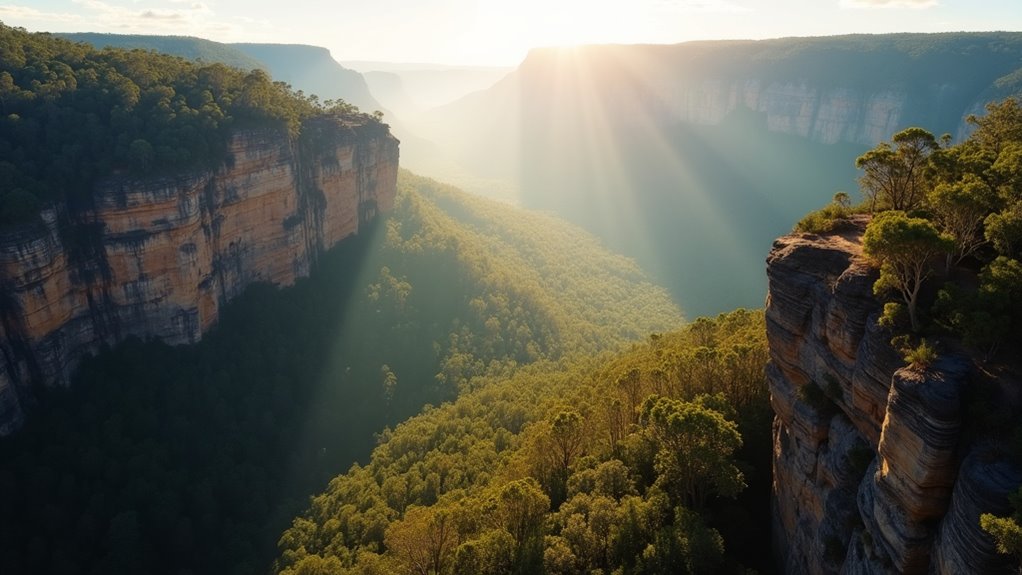
Discover Australia's top 13 bushwalking trails, from ancient Aboriginal paths to dramatic coastal cliffs, each promising unforgettable wilderness adventures.
Like a carefully curated map collection, Australia’s bushwalking trails offer you distinct pathways into the continent’s soul. You’ll find ancient Aboriginal sites, rare wildlife encounters, and dramatic landscapes that range from alpine peaks to coastal cliffs. Whether you’re planning a day hike or a multi-week adventure, these 13 trails represent the most rewarding routes you can tackle on any budget. Let’s explore how each trail earned its place among Australia’s finest walking destinations.
While the Overland Track serves as Tasmania’s most renowned multi-day hike, you’ll need careful planning to tackle this 65-80 km alpine journey through Cradle Mountain-Lake St Clair National Park.
The trek requires a A$295 summer permit (October-May) plus a Tasmania Parks Pass ranging from A$12 to A$60.
You’ll encounter 27 km of boardwalk mixed with rooty, technical trails as you climb 2,623 meters through diverse terrain. The track typically takes six days to complete, starting at Ronny Creek and ending at Lake St Clair. Trekking poles are essential gear for maintaining stability on the challenging surfaces.
Essential tips for camping at new locations can help ensure a successful trip. You’ll find both camping spots and guided tour options with accommodations. Pack for unpredictable weather and bring emergency supplies, including a first aid kit.
During your journey, you’ll traverse pristine wilderness, spotting native wildlife like wallabies and birds in their natural habitat.
Moving from Tasmania’s alpine wilderness to Australia’s Red Centre, the Larapinta Trail offers a dramatically different bushwalking experience. This 223-kilometer trek from Alice Springs Telegraph Station to Mount Sonder takes you through some of Central Australia’s most striking landscapes. Navigation skills are essential as some sections feature rough unmarked tracks.
The trail’s grading reflects its challenging nature, so you should consider your fitness level and hiking experience before tackling this ancient path.
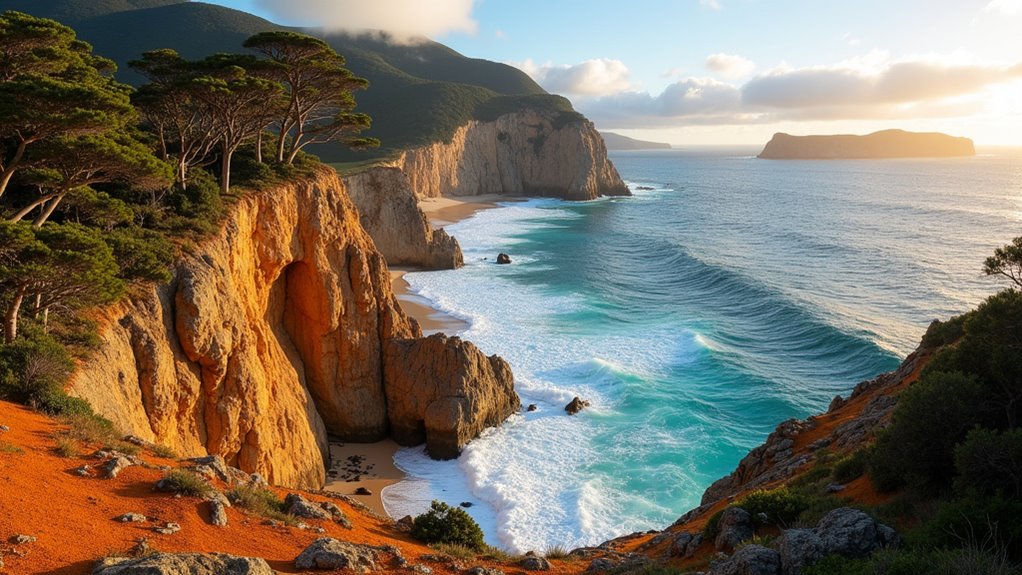
For travelers seeking a manageable yet stunning coastal trek, the Three Capes Track delivers an unforgettable 48-kilometer journey along Tasmania’s southeastern coast.
You’ll traverse well-maintained boardwalks, gravel paths, and stone steps over four days, staying in architecturally designed cabins each night.
The track takes you past dramatic sea cliffs at Cape Pillar and Cape Hauy, through eucalyptus forests and coastal heathlands.
You’ll witness breathtaking views of Tasman Island and the iconic Blade formation. Your journey begins with a scenic boat cruise to Denmans Cove. While moderate fitness is required, the trail’s infrastructure makes it accessible year-round.
You’ll need to book in advance and secure a permit.
The track provides story-seats and a guidebook to enrich your experience.
Consider both self-guided options and guided tours that include transfers and meals, depending on your comfort level.
Stretching an impressive 1,000 kilometers from Perth Hills to Albany, the Bibbulmun Track serves as Western Australia’s premier long-distance hiking trail.
The ancient Bibbulmun Track winds through Western Australia’s wilderness, creating an epic thousand-kilometer journey between Perth Hills and Albany.
You’ll find yourself immersed in diverse landscapes, from towering karri forests to dramatic coastal heathlands, with yellow Waugal markers guiding your journey. For optimal hiking conditions, plan your trek between May to October, avoiding the intense summer heat and potential bushfire risks.
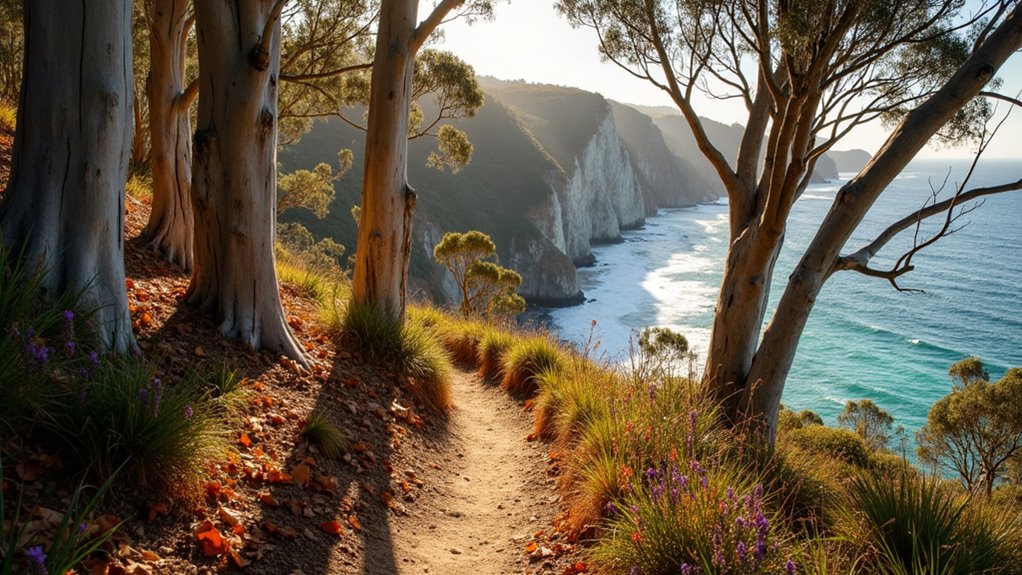
Winding through South Australia’s most spectacular landscapes, the 1,200-kilometer Heysen Trail connects Parachilna Gorge to Cape Jervis while offering hikers an incredible diversity of terrain.
You’ll traverse coastal paths, native bushland, rugged gorges, and historic wine regions like the Barossa Valley.
The trail’s southern section from Cape Jervis suits beginners and families, while the northern stretch challenges experienced hikers.
You can tackle the full 50-65 day journey or choose shorter segments to match your skill level. Remember to clean your gear thoroughly before entering different sections to prevent spreading plant diseases and pests.
The trail’s open from April to October, closing during fire season, though the Wild South Coast Way remains accessible year-round.
You won’t need permits for hiking, and you’ll find 55 campsites and huts along the way.
With 18 trail towns offering resupply points and transport connections, you can easily plan your adventure.
While South Australia’s Heysen Trail offers inland adventures, Tasmania’s Bay of Fires calls coastal enthusiasts with its pristine white beaches and distinctive orange-hued granite boulders.
You’ll find this 63km coastal paradise on Tasmania’s northeastern coast, where gum forests meet the sea and wallabies roam freely. The trail is renowned for its soft sandy beaches that make for comfortable walking conditions.
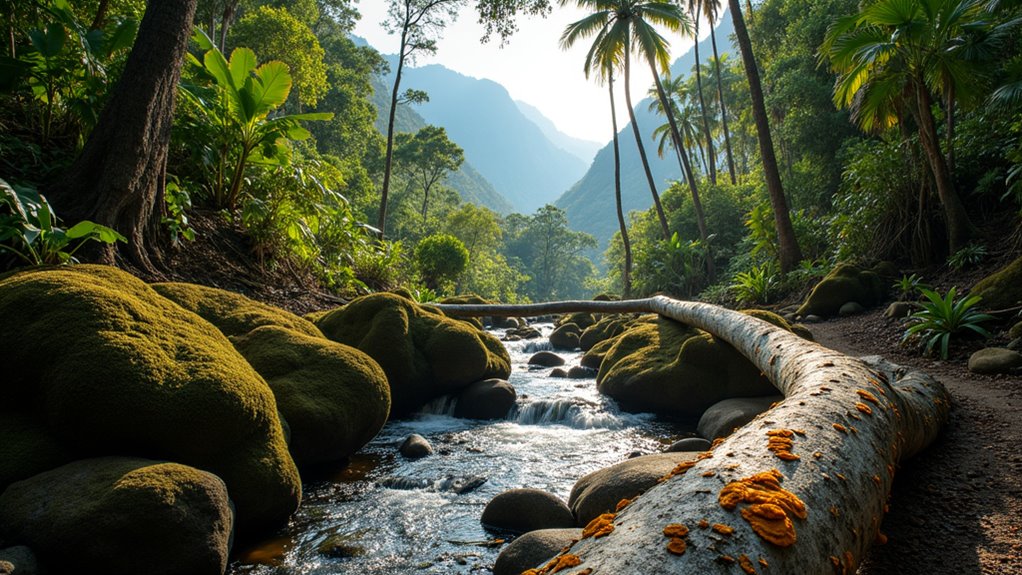
Located off Queensland’s tropical coast, the Thorsborne Trail offers one of Australia’s most secluded hiking experiences across Hinchinbrook Island’s pristine wilderness.
You’ll traverse 32 kilometers of diverse terrain, from empty beaches to rainforests and rocky headlands, typically over 3-4 days. The recommended hiking direction is north to south, allowing stunning views of waterfalls and vistas during the final days.
You’ll need to be self-sufficient and experienced, as you’re required to carry all supplies and a personal locator beacon. The trail’s demanding conditions include steep climbs, river crossings, and potential crocodile presence. Preparing properly is essential for a safe and enjoyable hike.
You must book permits well ahead, as only 40 people can access the trail at once.
Plan your trek during the dry season (April to September) for safer conditions.
You’ll find designated bush camps along the way, but remember: it’s strictly leave-no-trace hiking, and you must pack out all waste.
One of Australia’s most challenging long-distance treks, the Australian Alps Walking Track stretches 650-695 kilometers through Victoria, New South Wales, and the ACT.
Starting in Walhalla and ending in Tharwa, you’ll traverse some of Australia’s most rugged and remote terrain, including Mt. Kosciuszko, the continent’s highest peak. Experienced hikers typically complete the journey in twenty-four days, though this can vary based on conditions and ability.
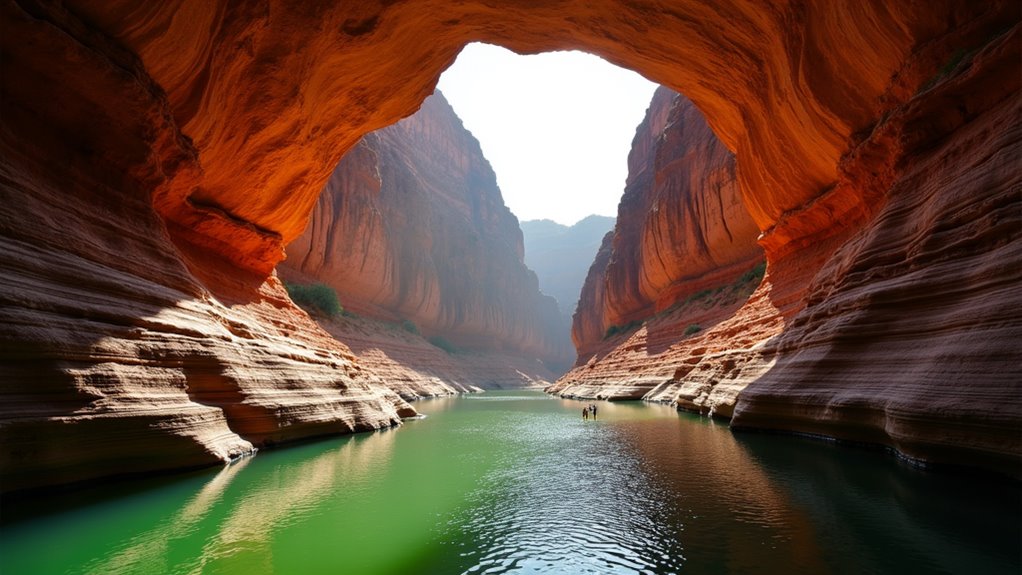
Deep within Western Australia’s north-west, Karijini National Park showcases some of Australia’s most spectacular gorge walks.
You’ll need a four-wheel drive or tour guide to navigate the rugged terrain, with Newman serving as your closest major town. Proper preparation and caution are essential when exploring the park’s unforgiving nature.
Each gorge offers distinct experiences. At Dales Gorge, you can tackle the four-kilometer trail featuring swimming spots and the challenging two-hour return hike to Circular Pool.
Hamersley Gorge, though remote, rewards you with dramatic colors and invigorating swimming holes. The gorge now features a sealed access road making it more accessible for visitors. For an easier option, head to Kalamina Gorge, where a five-minute descent leads to a serene waterfall and pool setting.
Before setting out, check trail conditions as weather can cause closures. Pack plenty of water and wear sturdy shoes to navigate the terrain.
Stretching an impressive 250 kilometers from Sydney to Newcastle, the Great North Walk combines urban landscapes with rugged bushland to create one of Australia’s most diverse long-distance trails.
You’ll need 10-16 days to complete this challenging route, which features relentless undulating terrain and significant river crossings. Hikers can experience stunning views of Sydney’s heritage homes and historic sites as the trail winds through the Lane Cove Valley. Essential camping tips should be kept in mind for first-time adventurers.
The fastest supported completion time stands at 1 day, 15 hours, and 9 minutes.
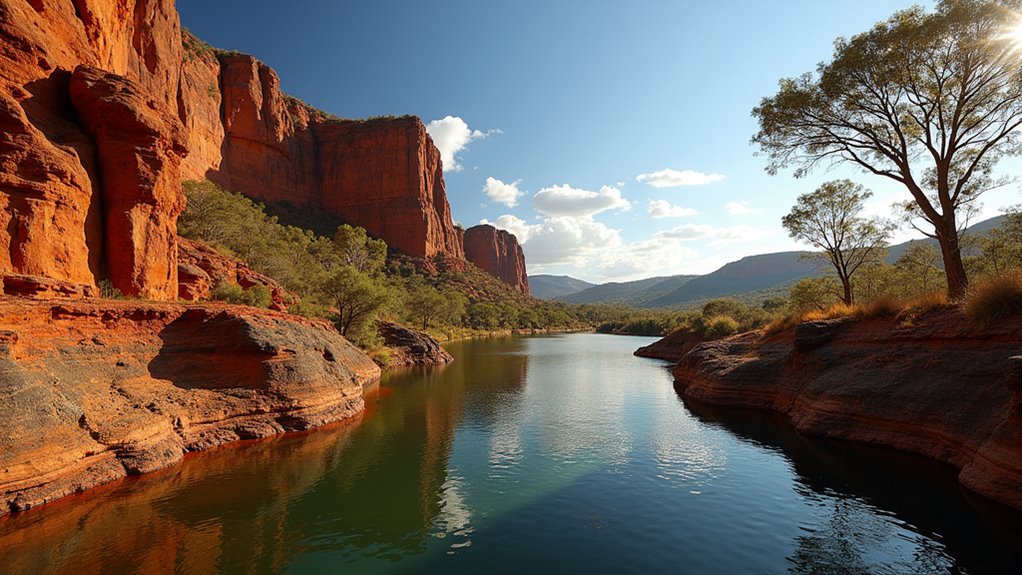
Towering sandstone cliffs of Kakadu National Park tell a story spanning 140 million years, where ancient seabeds transformed into a dramatic landscape of plateaus, gorges, and wetlands.
You’ll encounter six distinct landforms as you explore, from the 330-meter-high Arnhem Land escarpment to vast floodplains teeming with waterbirds. The rocky plateau offers challenging walks through sparse woodlands, while hidden gorges reveal sheltered monsoon forests housing unique species like Allosyncarpia ternata. The park’s massive size of 1.98 million hectares makes it Australia’s largest national park.
Don’t miss the remarkable rock art sites scattered throughout the park, showcasing over 20,000 years of Aboriginal history. These ancient galleries display various artistic styles and extinct animal species.
For the best bushwalking experience, combine routes that cover both the savannah woodlands, which make up 80% of the park, and the biodiverse wetland areas recognized by Ramsar listing.
Located at mainland Australia’s southernmost point, Wilsons Promontory offers an accessible coastal wilderness that won’t strain your budget. Just three hours from Melbourne, you’ll find 505 square kilometers of diverse landscapes ready to explore through various walking trails. Essential tips for a successful camping experience can help make your adventure even more enjoyable.
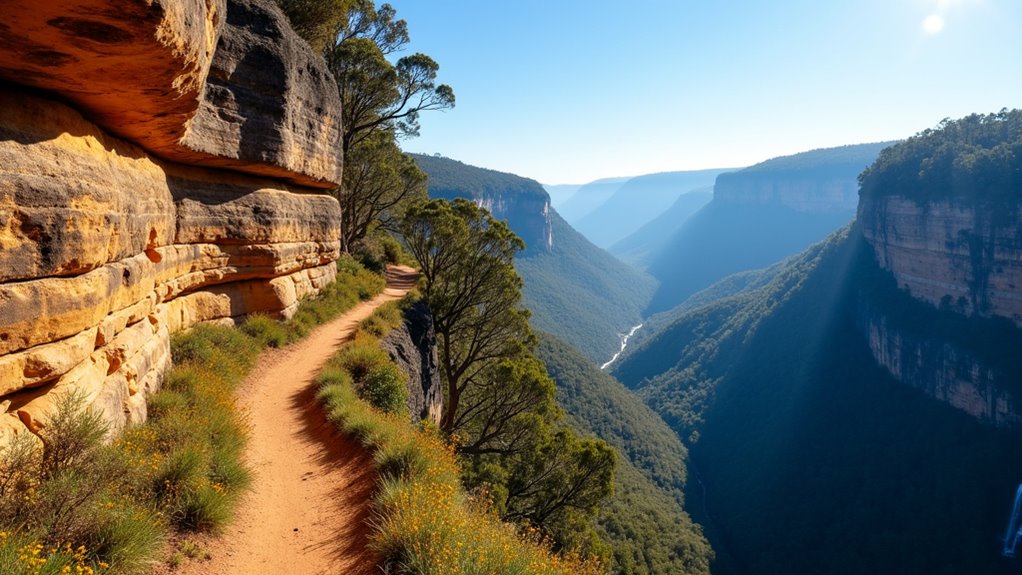
Just over an hour’s drive west of Sydney, the Blue Mountains offer world-class bushwalking without breaking the bank.
You’ll find over 1 million hectares of wilderness featuring dramatic sandstone cliffs, deep gorges, and ancient eucalypt forests that have earned UNESCO World Heritage status.
The area’s extensive trail network caters to all skill levels, from easy day walks to challenging multi-day treks. Essential tips for a safe and enjoyable camping adventure can help make your trip even more memorable.
You can spot native wildlife and rare plants, including the prehistoric Wollemi pine, while exploring the region’s eight protected areas.
Don’t miss the Aboriginal cultural sites scattered throughout the landscape, adding historical depth to your hiking experience.
The region supports an incredible 152 plant families, making it one of Australia’s most botanically diverse areas.
Free visitor centers provide detailed trail maps and local advice, while budget-friendly camping options let you extend your stay.
Public transport access from Sydney keeps transportation costs low.
You’ll find that Australia’s premier walking tracks span over 25,000 kilometers collectively, offering more trails than you could complete in a lifetime. With camping fees averaging just $15-30 per night at most national parks, these trails provide affordable adventure opportunities. Pack smart, plan according to seasons, and don’t forget to register your walks – 85% of rescue operations involve unregistered hikers. Your safety and preparation matter most.